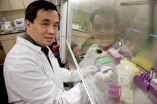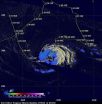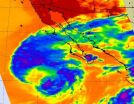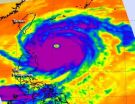(Press-News.org) PITTSBURGH, Sept. 27, 2012 – Lymph nodes can provide a suitable home for a variety of cells and tissues from other organs, suggesting that a cell-based alternative to whole organ transplantation might one day be feasible, according to researchers at the University of Pittsburgh School of Medicine and its McGowan Institute for Regenerative Medicine. In a report recently published online in Nature Biotechnology, the research team showed for the first time that liver cells, thymus tissue and insulin-producing pancreatic islet cells, in an animal model, can thrive in lymph nodes despite being displaced from their natural sites.
Hepatitis virus infection, alcoholic cirrhosis and other diseases can cause so much damage that liver transplantation is the only way to save the patient, noted senior investigator Eric Lagasse, Pharm. D., Ph.D., associate professor, Department of Pathology, Pitt School of Medicine. Children with DiGeorge syndrome lack functional thymus glands to produce essential immune cells, and diabetes can be cured with a pancreas transplant.
"However, the scarcity of donor organs means many people will not survive the wait for transplantation," said Dr. Lagasse, whose lab is at the McGowan Institute. "Cell therapies are being explored, but introducing cells into tissue already ravaged by disease decreases the likelihood of successful engraftment and restoration of function."
In the study, his team tested the possibility of using lymph nodes, which are abundant throughout the body and have a rich blood supply, as a new home for cells from other organs in what is called an "ectopic" transplant.
They injected healthy liver cells from a genetically-identical donor animal into lymph nodes of mice at various locations. The result was an enlarged, liver-like node that functioned akin to the liver; in fact, a single hepatized lymph node rescued mice that were in danger of dying from a lethal metabolic liver disease. Likewise, thymus tissue transplanted into the lymph node of mice that lacked the organ generated functional immune systems, and pancreatic islet cell transplants restored normal blood sugar control in diabetic animals.
"Our goal is not necessarily to replace the entire liver, for example, but to provide sufficient cell mass to stabilize liver function and sustain the patient's life," Dr. Lagasse said. "That could buy time until a donor organ can be transplanted. Perhaps, in some cases, ectopic cell transplantation in the lymph node might allow the diseased organ to recover."
###
Co-authors of the paper include Junji Komori, M.D., Ph.D., Lindsey Boone, Ph.D., and Aaron DeWard, Ph.D., all of Pitt's Department of Pathology and the McGowan Institute, and Toshitaka Hoppo, M.D., Ph.D., of the McGowan Institute.
The project was funded by National Institutes of Health grants P30CA047904 (through the University of Pittsburgh Cancer Institute) and R01 DK085711.
About the University of Pittsburgh School of Medicine
As one of the nation's leading academic centers for biomedical research, the University of Pittsburgh School of Medicine integrates advanced technology with basic science across a broad range of disciplines in a continuous quest to harness the power of new knowledge and improve the human condition. Driven mainly by the School of Medicine and its affiliates, Pitt has ranked among the top 10 recipients of funding from the National Institutes of Health since 1997. In rankings recently released by the National Science Foundation, Pitt ranked fifth among all American universities in total federal science and engineering research and development support.
Likewise, the School of Medicine is equally committed to advancing the quality and strength of its medical and graduate education programs, for which it is recognized as an innovative leader, and to training highly skilled, compassionate clinicians and creative scientists well-equipped to engage in world-class research. The School of Medicine is the academic partner of UPMC, which has collaborated with the University to raise the standard of medical excellence in Pittsburgh and to position health care as a driving force behind the region's economy. For more information about the School of Medicine, see www.medschool.pitt.edu.
http://www.upmc.com/media
Liver cells, insulin-producing cells, thymus can be grown in lymph nodes, Pitt team finds
2012-09-28
ELSE PRESS RELEASES FROM THIS DATE:
Genetic sleuthing uncovers deadly new virus in Africa
2012-09-28
An isolated outbreak of a deadly disease known as acute hemorrhagic fever, which killed two people and left one gravely ill in the Democratic Republic of Congo in the summer of 2009, was probably caused by a novel virus scientists have never seen before.
Described this week in the open-access journal PLoS Pathogens, the new microbe has been named Bas-Congo virus (BASV) after the province in the southwest corner of the Congo where the three people lived.
It was discovered by an international research consortium that included the University of California, San Francisco ...
NASA sees light rainfall in Tropical Storm Nadine
2012-09-28
NASA's TRMM satellite noticed that the intensity of rainfall in Tropical Storm Nadine has diminished today, Sept. 27.
The Tropical Rainfall Measuring Mission or TRMM satellite passed over Tropical Storm Nadine on Sept. 27 at 0739 UTC (4:39 a.m. EDT) and at 0917 UTC (5:17 a.m. EDT). At NASA's Goddard Space Flight Center in Greenbelt, Md., several TRMM instruments were used to create a full picture of Nadine's weakened rainfall. The image was created with an enhanced infrared image from TRMM's Visible and InfraRed Scanner (VIRS) overlaid with rainfall data derived from ...
Simulations uncover 'flashy' secrets of merging black holes
2012-09-28
VIDEO:
Supercomputer models of merging black holes reveal properties that are crucial to understanding future detections of gravitational waves. This movie follows two orbiting black holes and their accretion disk during...
Click here for more information.
According to Einstein, whenever massive objects interact, they produce gravitational waves -- distortions in the very fabric of space and time -- that ripple outward across the universe at the speed of light. While astronomers ...
Landsat satellites find the 'sweet spot' for crops
2012-09-28
Farmers are using maps created with free data from NASA and the U.S. Geological Survey's Landsat satellites that show locations that are good and not good for growing crops.
Farmer Gary Wagner walks into his field where the summer leaves on the sugar beet plants are a rich emerald hue -- not necessarily a good color when it comes to sugar beets, either for the environment or the farmer. That hue tells Wagner that he's leaving money in the field in unused nitrogen fertilizer, which if left in the soil can act as a pollutant when washed into waterways, and in unproduced ...
NASA sees a western weakness in Tropical Storm Miriam
2012-09-28
NASA infrared satellite imagery showed Tropical Storm Miriam had strong convection and thunderstorm activity in all quadrants of the storm on Sept. 26, except the western quadrant. That activity waned dramatically in 24 hours because of strong wind shear and cooler sea surface temperatures.
The Atmospheric Infrared Sounder (AIRS) instrument that flies aboard NASA's Aqua satellite captured infrared data on Tropical Storm Miriam on Sept. 26 at 2047 UTC, when it was off the coast of Baja California. Strongest thunderstorms with very cold cloud top temperatures appear to ...
NASA sees a wide-eyed Super Typhoon Jelawat
2012-09-28
One day ago, Super Typhoon Jelawat's eye was about 25 nautical miles in diameter, today, Sept. 27, NASA satellite data indicated that eye has grown to 36 nautical miles!
The latest infrared image from the Atmospheric Infrared Sounder (AIRS) instrument that flies on NASA's Aqua satellite shows a clear eye in Typhoon Jelawat on Sept. 25. The cloud top temperatures of the thunderstorms surrounding the eye exceed -63 Fahrenheit (-52 Celsius) indicating that they are very powerful and heavy rainmakers.. Jelawat also has a rounded shape indicating that circulation is strong ...
NASA sees Tropical Storm Ewiniar embedded in low pressure
2012-09-28
NASA's Aqua satellite passed over Tropical Storm Ewiniar and noticed strong convection still persists in the storm, despite now being embedded in a subtropical area of low pressure off the coast of Japan.
As Tropical Storm Ewiniar continues to move northward it wound up in an elongated area of low pressure (called a trough) off Japan's east coast. The trough is bringing a strong westerly flow of air into Ewiniar. Despite being battered by those winds, infrared data from the Atmospheric Infrared Sounder (AIRS) instrument that flies aboard NASA's Aqua satellite is showing ...
Study shows the MDHearingAid to be an effective low cost solution to hearing loss
2012-09-28
Washington, D.C. - A study presented at the American Academy of Otolaryngology - Head & Neck Surgery Foundation Annual Meeting in Washington, D.C. shows that the MD Hearing Aid line offers a reasonable low-cost solution to those who are not using hearing aids or other amplification devices because of cost concerns.
In the study, researchers at the Michigan Ear Institute sought to evaluate a novel, inexpensive (under $200.) over- the-counter hearing aid regarding to its acoustic properties and also to test the hearing aid on patients with varying levels of hearing loss ...
Major genetic discovery explains 10 percent of aortic valve disease
2012-09-28
This press release is available in French and German.MONTREAL, Canada, September 28, 2012 - Researchers at the Sainte-Justine University Hospital Center and University of Montreal have identified genetic origins in 10% of an important form of congenital heart diseases by studying the genetic variability within families. "This is more than the sum of the genes found to date in all previous studies, which explained only 1% of the disease, says Dr. Marc-Phillip Hitz, lead author of the study published in PLOS Genetics, under the direction of Dr. Gregor Andelfinger, pediatric ...
Making headway on beta-blockers and sleep
2012-09-28
Boston, MA—Over 20 million people in the United States take beta-blockers, a medication commonly prescribed for cardiovascular issues, anxiety, hypertension and more. Many of these same people also have trouble sleeping, a side effect possibly related to the fact that these medications suppress night-time melatonin production. Researchers at Brigham and Women's Hospital (BWH) have found that melatonin supplementation significantly improved sleep in hypertensive patients taking beta-blockers.
The study will be electronically published on September 28, 2012 and will be ...





